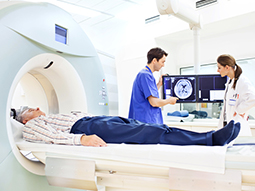A varicocele is an enlarged vein located in the male testicles and/or scrotum. Although varicoceles are fairly common in men ages 15-35, they may sometimes cause issues with fertility if they reduce sperm motility (movement). Varicocele embolization is the preferred treatment for men with a varicocele who are interested in preserving or improving their fertility. An embolization creates a blockage in the blood vessel feeding the varicocele to prevent further growth and ultimately shrink the vein back down to its original size.
Why varicocele embolization is performed
A varicocele is commonly diagnosed via physical examination or laboratory results. A man may have symptoms (like pain or a lump in the scrotum) or may be referred for evaluation due to low sperm count. If a physician cannot detect a varicocele but suspects one is present, an imaging test may be ordered to show any abnormal vessels or veins.
Surgery is one treatment option for varicoceles, but for men seeking help to aid with conception, varicocele embolization is typically the recommended approach. Studies have shown that patients undergoing this less invasive procedure experienced higher rates of conception and sperm count improvement, compared to patients who underwent surgery.
What to expect during varicocele embolization
Varicocele embolization is an outpatient treatment performed by an interventional radiologist. Patients are given sedative medication and local anesthesia prior to the procedure. After numbing the groin and making a small incision, the interventional radiologist inserts a catheter (thin plastic tube) through the femoral vein and to the testicle. Imaging guidance is used to help the provider safely insert the catheter. From here, venous blood flow is blocked by injecting embolizing agents (safe materials such as coils or grains that can create a blockage). Once blood flow is re-routed to a healthy vein, the pressure on the vein is reduced. Over time, this will lead to improvements with sperm quantity and quality.
Risks and benefits of varicocele embolization
Varicocele embolization is a safe procedure that has been demonstrated to help with male fertility challenges. Some studies show that up to 50 percent of men who undergo this treatment conceive in a year. Patients report a very short recovery time, with most returning to normal daily activities nearly immediately.
As with any medical procedure, there is a risk of infection. However, this risk is low as varicocele embolization is not an open surgery. The catheter insertion also carries minor risks of bleeding, bruising, and blood vessel damage. Despite the usage of X-ray imaging for procedure precision during varicocele embolizations, there is a small risk that surrounding healthy tissue may be affected by the embolizing particles.
How to prepare for varicocele embolization
A semen sample may be taken to compare sperm quality pre- and post-procedure. Patients should speak with their care team about all medications they are taking, as some may need to be paused ahead of the procedure. As with any procedure, known allergies will also be reviewed. If sedation is going to be used, patients will be instructed on when to stop eating and drinking ahead of the scheduled appointment. Patients who have sedation will need someone to drive them home after the procedure.
Post varicocele embolization
Patients will recover in the hospital until completely awake before being discharged home. Most men are able to resume their normal, daily activities the following day.
Our providers

Expert radiology care
Getting the care you need starts with seeing one of our radiologists.









